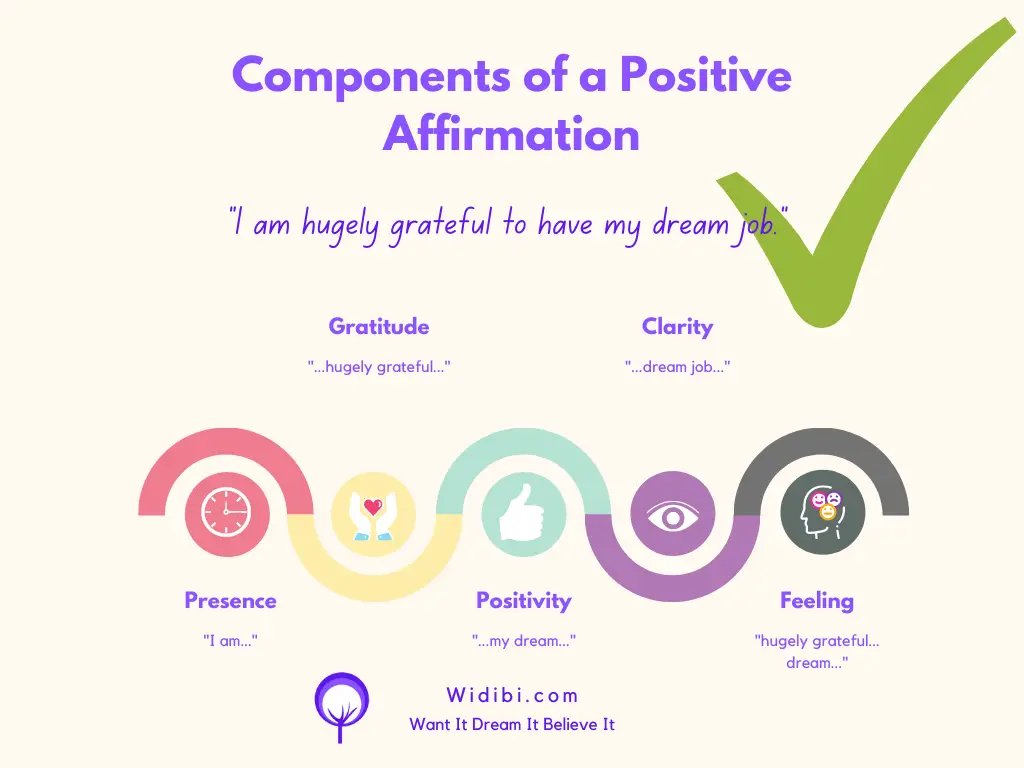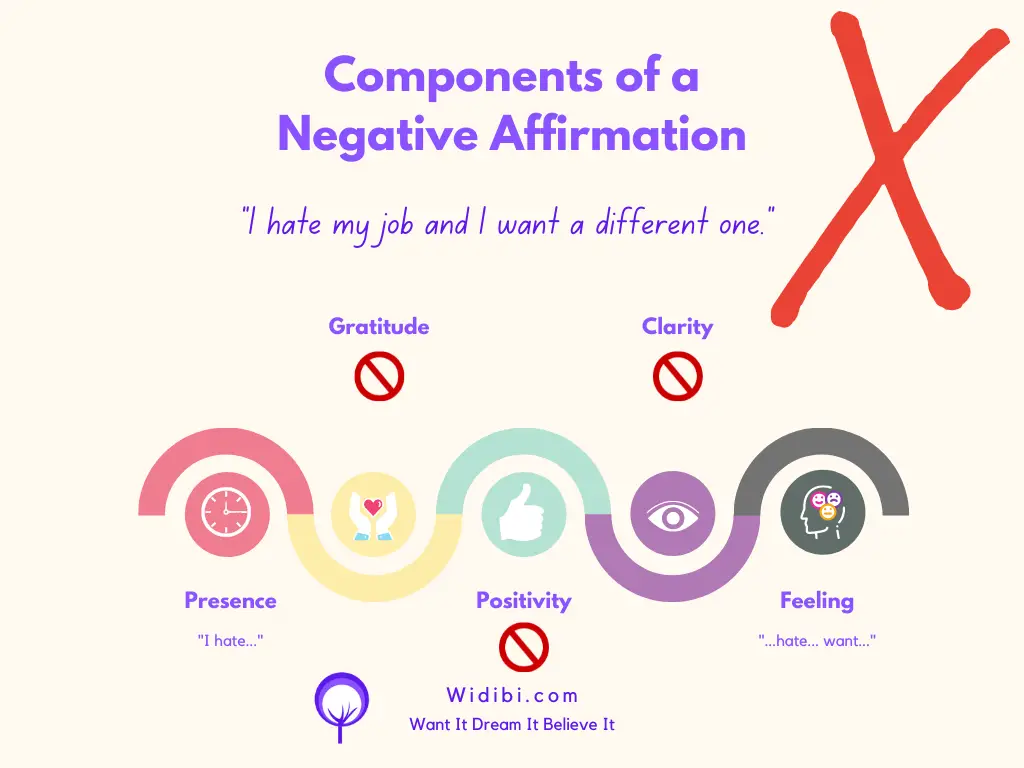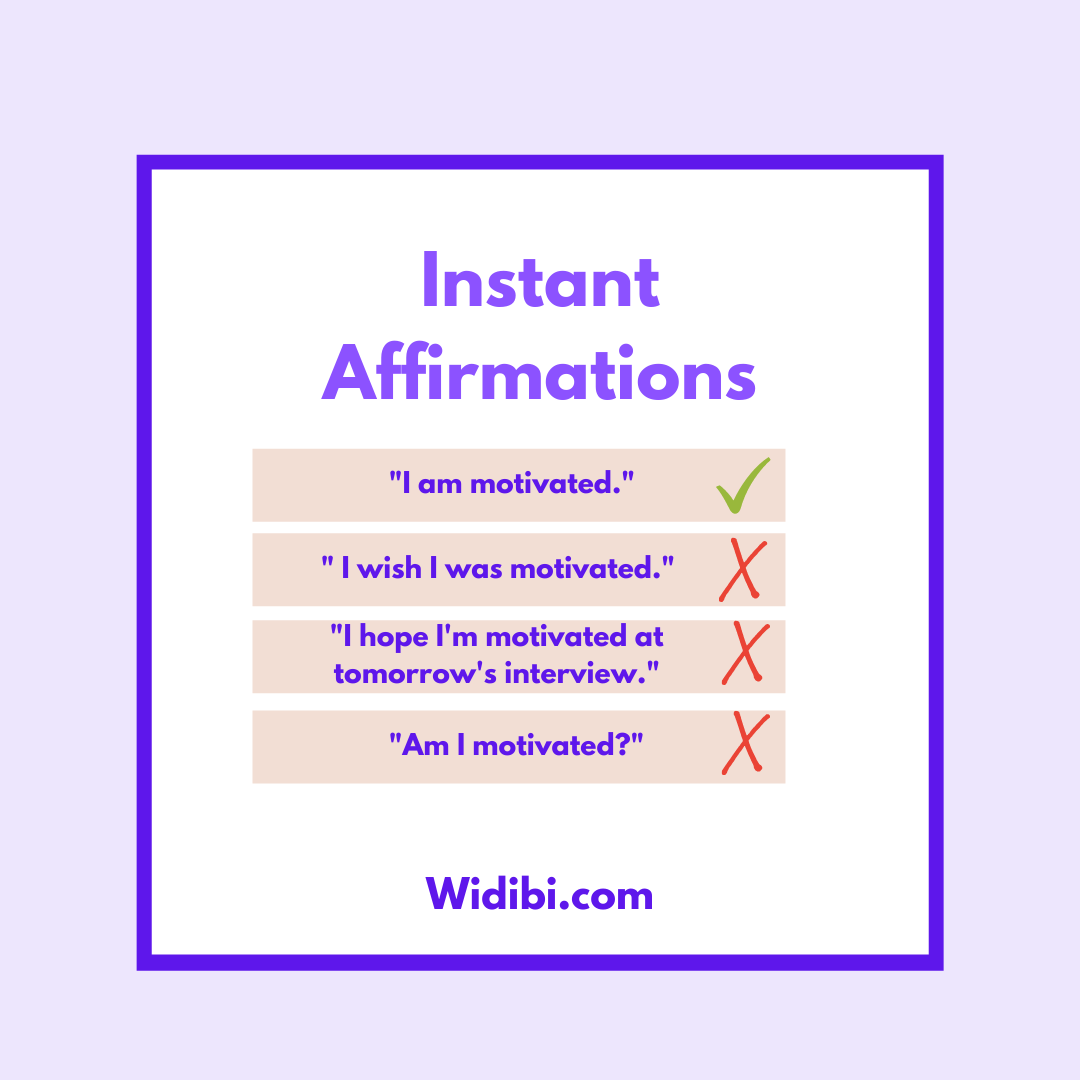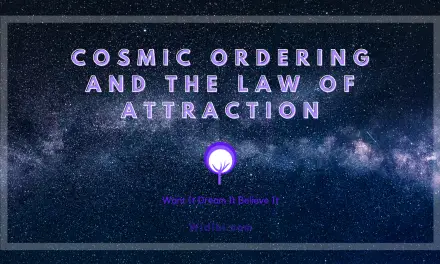We’ve written extensively here at Widibi about manifesting, the law of attraction, vision boards and much more. In this article, I want to go back to basics and cover how to write an affirmation.

Affirmations could be considered the building blocks of the law of attraction. If anyone wants to use the practice to manifest their desires or otherwise alter their reality, they’re all but essential. Most vision boards incorporate at least one or two affirmations. The most popular written manifesting techniques, from manifestation journals to the 369 method, all rely on affirmations.
In This Article
Why Do Affirmations Matter So Much?
Affirmations fulfil the role of building blocks in wielding the power of the law of attraction because they’re the best way to clearly tell the universe precisely what it is you’d like to manifest or achieve. But, crucially, they also incorporate what I’ve taken to calling the five pillars of successful affirmation:
- Presence – The universe doesn’t share a concept of time with us, and not having something yet isn’t a genuine concept in the law of attraction. As far as the universe is concerned, you already have what you want and need. You may not have it yet in your physical form, but rest assured that it’s on its way. As such, you should always construct your affirmations in the present tense.
- Gratitude – The universe is selfless and doesn’t sulk if and when it does something nice for someone and goes unthanked. However, your gratitude in affirmations isn’t there to congratulate the forces around us for a job well done. Instead, think of it more as confirmation. I’ll move on to feeling as a more general pillar below, but gratitude in itself contributes to both the feeling and positivity aspects of affirmations. Furthermore, it confirms to the universe that you’ve received what you want, boosting your power and control as you go ahead and manifest further.
- Positivity – Affirmations also thrive on positivity and confidence. Positive energy is responsible for bringing what you’ve affirmed into being. Negative energies and emotions are less potent, so don’t worry if you’re not the most positive person in the world all the time. However, you can embolden your affirmations through a positive tone – you’re confident, you’re delighted, and you’re motivated. When accompanied by a matching frame of mind, these expressions let the universal energies know that you mean business.
- Clarity – The perfect affirmation is clear about what you want and why you want it – but doesn’t ever refer to ‘want’. Instead, refer back to presence – it’s all about composing an affirmation that speaks and thinks something into your now.
- Feeling – Successful manifestation through affirmations thrives on emotion. So whether you write, say or think your affirmations in pursuit of your goal, try to do it in an emotive way. If your voice cracks when you say a particular affirmation because you’re just that passionate about it, you’ve created an affirmation that’s all but certain to yield fantastic results!

How to Write Positive Affirmations
You may well have heard of the importance of positive affirmations long before reading this feature. While affirmations don’t have to be positive, good ones are.
Just as you write affirmations in the present to bring them into your now, I’ll assume that you want your manifestations to be positive and have a progressive impact on your life.
Take these two affirmation examples:

“I am hugely grateful to have my dream job.”

“I hate my job and I want a different one.”
Both qualify as affirmations. Both can be said, thought or written.
The first one has all the essential ingredients of a great affirmation:
Presence: “I am…”
Gratitude: “…hugely grateful…”
Positivity: “…my dream…”
Clarity: “…dream job…”
Feeling: “…hugely grateful… dream…”
The second has some, but not all:
Presence: “I hate…” rather than “…hated…” or “…will hate…”
Gratitude: None at all
Positivity: Still nothing
Clarity: It’s clear the individual doesn’t want what they have. Indeed, they want something else – but are they sure of what?
Feeling: “I hate…” It’s certainly a feeling, but not one that anyone would recommend dwelling on or manifesting.
If you believe in manifestation, you have to accept that manifesting happens all the time. Like a nosey neighbour, the universe is always listening, even if we’re not speaking to it directly.
In typical conversation, “hate” is far more potent than “want”. Remember, however, that the universe thrives on giving more of the same. With manifesting and affirmations, that means if you give off the energy of hate, you’ll continue to hate something. For example, I hate bananas, and I’m entirely okay with the universe continuing to manifest that hatred!
Unsurprisingly, if you want something, you’ll continue to want it. But, more importantly, you won’t have it because it’s difficult to want something you already have unless you’re focused on acquiring more of the same.
The Simple Power of Written Affirmations
Anyone that has ever found success through affirmations will tell you anyone can do the same, and I’d be the first to agree. Part of the power of affirmations lies in their simplicity. I wrote around 350 words above on what the perfect affirmation consists of, but you don’t need to come anywhere close to that.
Most affirmations are no more than a single sentence. The words themselves are secondary. What really matters is what those words make you think and how they make you feel. Take this example:
“I am motivated.”
It’s three words. Nevertheless, it’s a potentially potent affirmation that can serve as a building block towards your future success.
Say it out loud. How does it make you feel? In some cases, you might feel ready to work harder, tackle a problem or head to the gym for the first time this week. By saying you’re motivated, you might have brought that into being.
You might not immediately feel more motivated, but I bet those three words at least got you thinking. Your thoughts might extend the affirmation – “I am motivated to…” – and that too can make all the difference.

Motivation has a definition, of course, but it’s open to interpretation. The feeling of being motivated and what you want to be motivated to do will differ from person to person.
Once again, if you’re wondering how to write an affirmation, don’t get hung up on the content. As long as you can say you’ve checked off the five pillars of successful affirmation as outlined above, that’s enough.
Some people choose to go into further detail. For example, some people use law of attraction scripting, where they write out their goals and dreams in great detail. There’s nothing at all wrong with that, but affirmations can work just as well while being quicker and simpler.

The best affirmations go beyond the words on a page. They capture how you felt when you created the affirmation and elicit thoughts and emotions that help the universe to manifest your desires.
How to Write Affirmations in the Present Tense
The simplest way to explain writing affirmations in the present tense is to picture yourself living whatever it is you’re affirming.
If your affirmations are designed to bring something into your life through manifestation, then the chances are that you don’t yet have what you want. However, your affirmation is an opportunity to live it and get into the mindset you’ll have when your manifestation arrives.
It couldn’t be easier. All you need to do is start every affirmation with “I” or “my”, then ensure there’s no hint of the past or the future.
A great affirmation starts with “I am”, not “I will”, “I did”, or “I could”.
An equally perfect affirmation could start with “My _____ is,” not “My _____ will,” or “My _____ was.”
No matter the thought process behind your affirmation, write it as if you’re living it. Of course, the past and future will influence the reasoning behind your affirmations, but when it comes to making things happen, it’s all about the here and now.
The same applies to personal, one-off affirmations. Not every affirmation contributes to a manifestation in the conventional sense. The example above, “I am motivated,” isn’t looking to manifest something physical. However, it does call upon the universe to manifest motivation.
Following the same outline as before, focus on the here and now, and save your affirmation for when you need it. Unfortunately, the universe’s incompatibility with our concept of time means you can’t schedule an affirmation for later!

Affirmations work best when you’re in the moment. While you can decide what your affirmation is ahead of time, make sure you say, think or write it when you need it. Before you know it, you’ll have mastered instant affirmations!
How to Write an Affirmation for Someone Else
You write an affirmation for someone else just as you would for yourself – with presence, gratitude, positivity, clarity and feeling.
One of the core rules of the law of attraction involves mastery over your own domain. You control your existence and the things around you. However, you can’t use affirmations to change someone else’s life, especially if they don’t want you to.
So, if you’re thinking of writing affirmations that will alter the reality of those around you, you’ll need to realign your priorities. What I mentioned earlier about affirmations always starting with “I” or “my” still holds true. “He is” or “they are” don’t hold weight in the affirmation world, even if they fit the bill of present tense.
However, that’s not to say you can’t support others through affirmations. For example, you might have told a friend how your life has changed for the better since you started making affirmations. You could regale them with tales of how when you want to feel as confident as possible; you simply say out loud: “I am supremely confident.” They might want it too, but they may not know where to start.
You could point them in the direction of this article (the share buttons are at the end!), or you could start their affirmation journey by crafting some for them. They still only need to be a single sentence.
Ask them what they would like to change, then use the guidance above to transform a desire into an affirmation. For example, they might tell you that they’re constantly stressed and worried, causing them to struggle to concentrate. You can then formulate that into an affirmation to change things up:
“I’m extremely thankful to be calm, composed and in control of everything around me.”
It’s as simple as that when you write an affirmation for someone else:
- Identify their issue
- Consider the emotions and feelings that would make those problems a non-issue
- Condense those feelings into a single sentence they can say, think or write using the five pillars of successful affirmation
Of course, you can’t do all the work for them. So, by all means, formulate an affirmation on their behalf, but do reinforce the need for them to put it into practice on their own time!
How to Write Affirmations for Manifestation
Affirmations for visualisation use all the ingredients of the five pillars, together with a healthy dose of visualisation wherever possible. In addition, presence takes on additional meaning when affirming for manifestation. You need to be confident in seeing yourself doing, using or living whatever it is you hope to manifest.
Given your affirmation’s role in getting you into the correct mindset, you might adjust the format slightly to be more descriptive. For example, let’s say you want to manifest a Nissan 370Z – a great car and a realistic manifestation goal for most budgets.

“I’m so thankful to be able to drive my red Nissan 370Z down the open highway with the wind blowing in my hair.”
Your affirmation is still only one sentence, but you’ve written down a couple of specifics that, over time, will instantly transport you to visualising what you’ve affirmed. Descriptive affirmations such as this, perhaps accompanied by a picture, are also a fantastic addition to a manifestation vision board if you use them.
Any More Questions on How to Write an Affirmation?
If you’ve got any further questions about how to write an affirmation, don’t hesitate to get in touch with the team or leave a comment below! First, I’ll round things off with some of the most common questions around writing affirmations and, of course, the answers!
How Often Should You Write Affirmations?
There are no hard and fast rules around how often you should write affirmations. Some people write their affirmations down every day. Some even do it multiple times each day, usually first thing in the morning or last thing at night. If you combine your affirmations with a manifestation technique, such as the 369 manifestation method, then the technique itself will stipulate how often to write them down and for how long.
Of course, if you just need a quick pick-up, such as with the instant affirmations outlined above, you can say them whenever you need them!
How Many Times Should I Write Affirmations Down?
You should write affirmations down when you have the time and focus on getting into the right headspace and repeating them until you’re confident in them. As mentioned above, the words themselves and the act of saying, thinking or writing them are essential but not the primary goal of affirmations. Instead, they’re a tool to get you to feel positive, focused and grateful while confirming that you really do want what your affirmation refers to.
I keep my affirmations in the notes app on my phone and have an action on my to-do list to check it. I use Microsoft’s To Do app, where you check things off as they’re done, accompanied by a cheerful ping sound. I’ve built the habit of checking the to-do list throughout the day, including first thing in the morning. I open up the notes app, read my affirmations aloud, add any new ones, and check it off for the day.
I may return to them later to repeat the process, or I might not. Once a day is sufficient for me. I know that it’s impossible to write down affirmations too often, so I might work on them multiple times if the fancy takes me. If I don’t, I remain confident that they’re working.
Where Should I Write Affirmations?
You should write your affirmations somewhere that they’re easily accessible, where you can refer back to them to reinforce their work and positivity.
Consider where you do your best written work. I can’t really explain it, but when I want to put emotion or a specific tone into words, my first preference is always pencil and paper. I’m particular about it being a pencil, too, not a pen.
Also think about where writing them would serve you best. Do you want to be constantly reminded of your affirmations? Write them on a phone app and save them as your wallpaper. Do you want them to hand wherever you might be but to keep them otherwise private? Keep them on your phone in the notes app without prominently displaying them.
Don’t forget; you can also write affirmations down in a dedicated book or document. I love the concept of manifestation journals, and they’re a perfect home for your affirmations if you don’t always need easy access. I love vision boards, too, and if you put your affirmation on there, you’ll be reminded of what you’ve committed to every time you look at it.
How to Write an Affirmation – In Summary
Wrapping up, writing an affirmation is all about condensing presence, gratitude, positivity, clarity and feeling into a sentence. First, decide what you want, whether its an emotional boost, a physical manifestation or anything else that comes to mind, then express it in a few words that check off all five requirements.
- Start with “I” or “my.”
- Confirm that you’re thankful for what you’re affirming
- Pretty up the affirmation with positivity – “amazing”, “beautiful”, “blessed”, “exciting”, “flourishing” and so on
- Be specific about what you’re affirming – a job, a car, a person, an emotion, money or anything else
From there, simply have faith and confidence in your affirmation, safe in the knowledge that you’ve spoken it into your reality.











